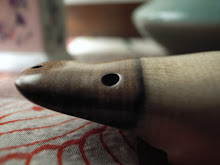
The side view depicts her sitting on the chair vertical. Excellent!


When I observed her from her back, however, I noticed that her right shoulder was slightly lower than the left one. My impression was that the weight of her upper body was supported by her lower back and its right side was particularly loaded with her weight. She told me of her pain around the neck-shoulder and her lower back. It is reasonable to conjecture that her pain is caused by her posture, i.e., the spine turning rightwards.
She was not aware of her posture until I pointed it out to her. It is hard for anyone to notice the slight bent especially on stage because the feature is so subtle that it is easily hidden by clothing. She knew however that there was a problem with her right shoulder as she feels difficulties when she put her clothes (Japanese Kimono) on her for stage performances. She said to me that she could not keep Kimono stay horizontal around her neck.

We discussed why her right shoulder tends to be lowered. Ms. Takagi pointed it out to me that she needed to pluck the third string, the furthest string, which requires her to push her right arm forward. That is right.


I may add to her comment that she is also holding her left arm (mostly) up to run her fingers on the instrument's neck. Hm... Similar phenomena are likely to be found for the Guitar players, too.


She told me that she used to sit down on the flour when she learnt to play the instrument. She started learning quite early, say, around thirteen or fourteen years old. (I have to ask her for the exact year.) I asked her thus to sit dow on the flour. Her shoulders were now adjusted towards the vertical position. I am not completely sure why such an adjustment occurred. Was her upper body supported better by her lower back? hm...
I know there is a some relation between the posture and the way she sits down. I know other shamisen players not belonging to Tsugaru tradition, i.e., the players playing traditional Japanese music with quieter tone, do not hold the instrument that way. They tend to sit on straight on the flour, but their playing styles are more restricted compared to the ones for playing Tsugaru shamisen. Any solution to remove her pain while preserving both niceties?





